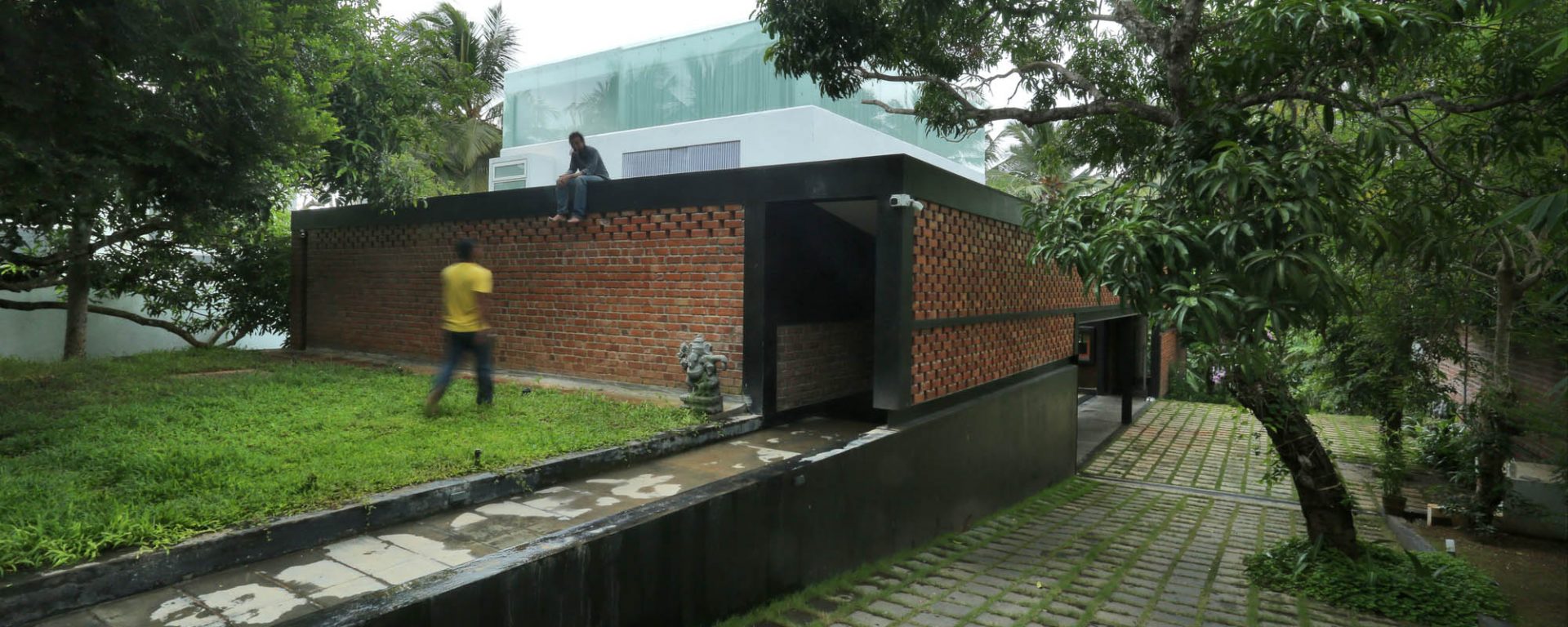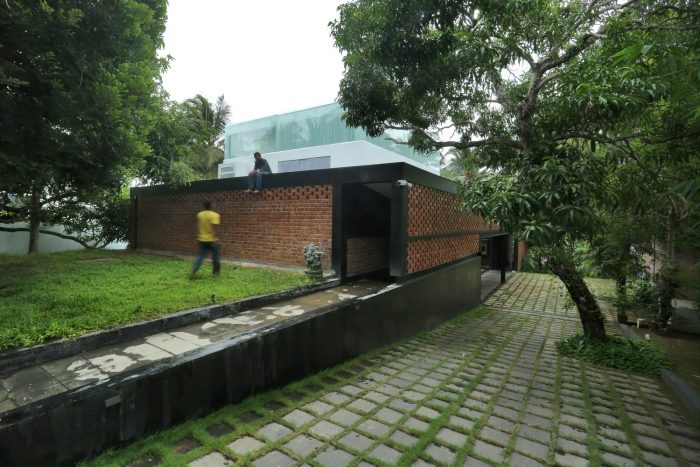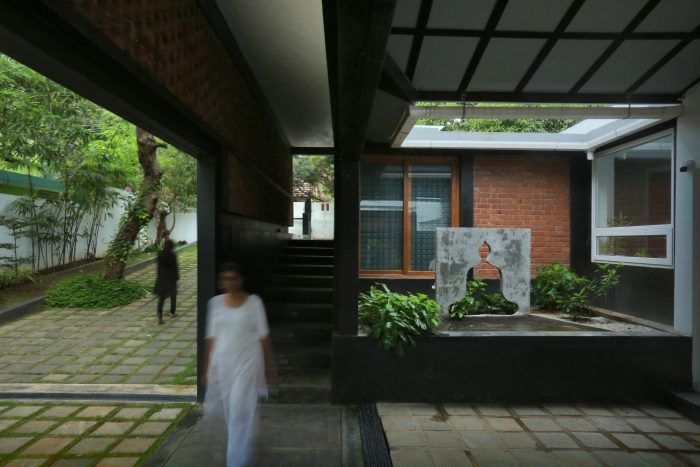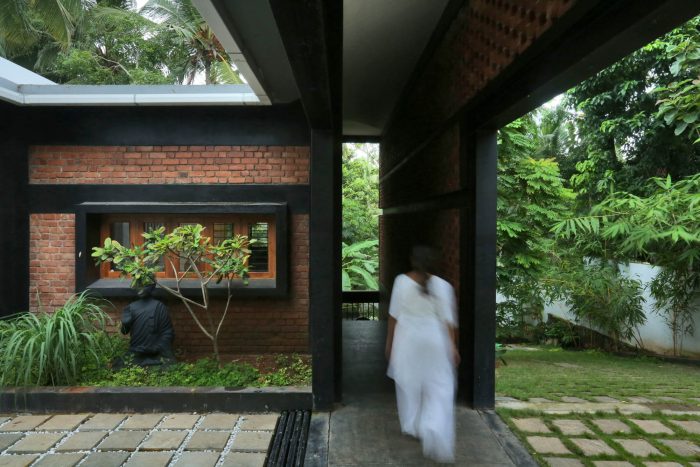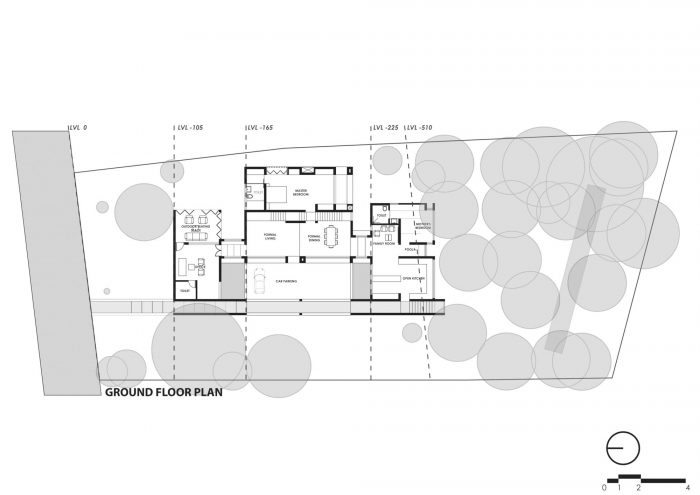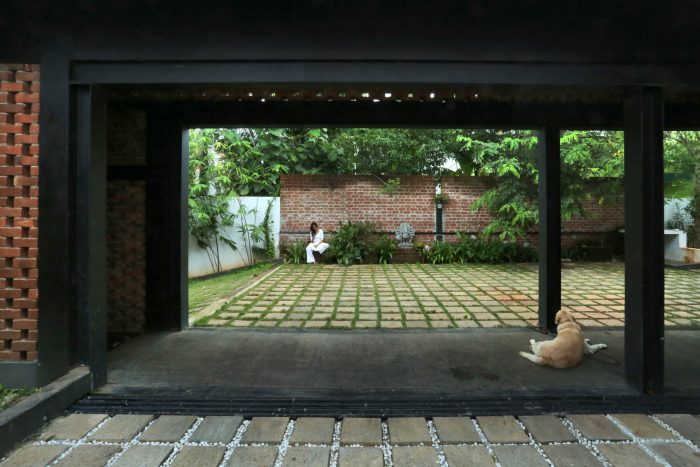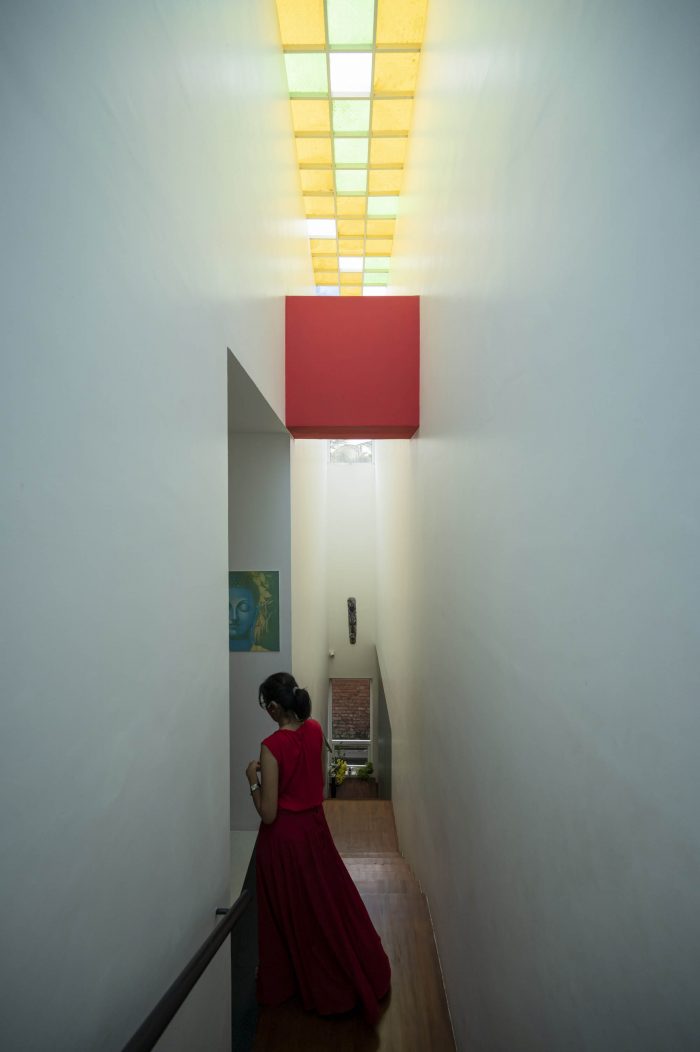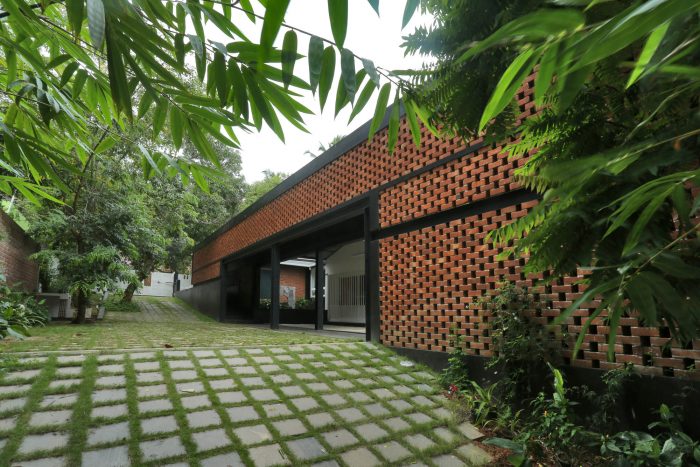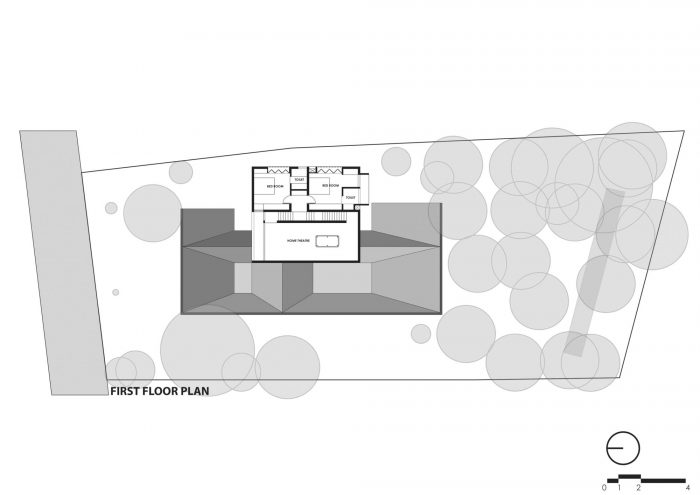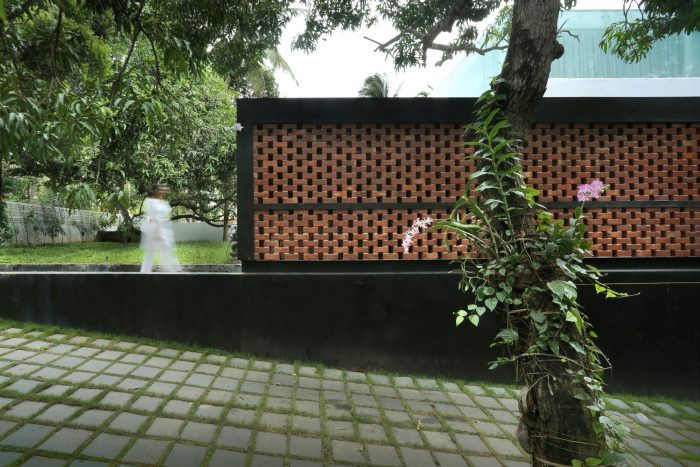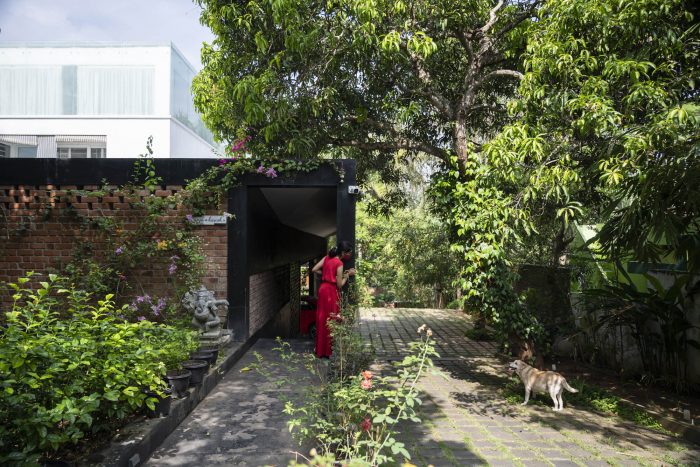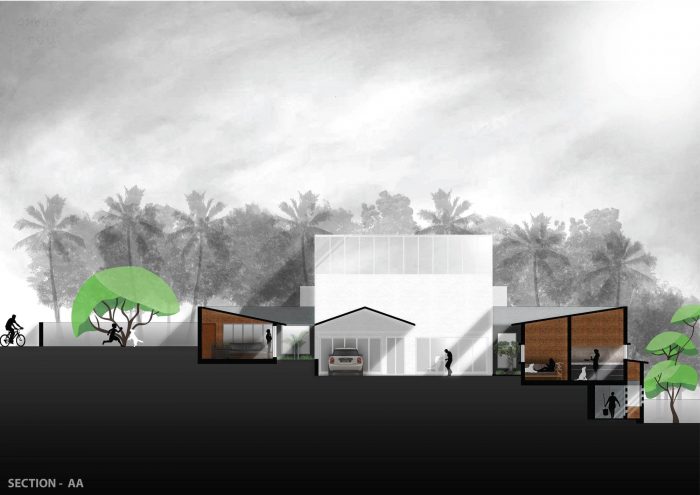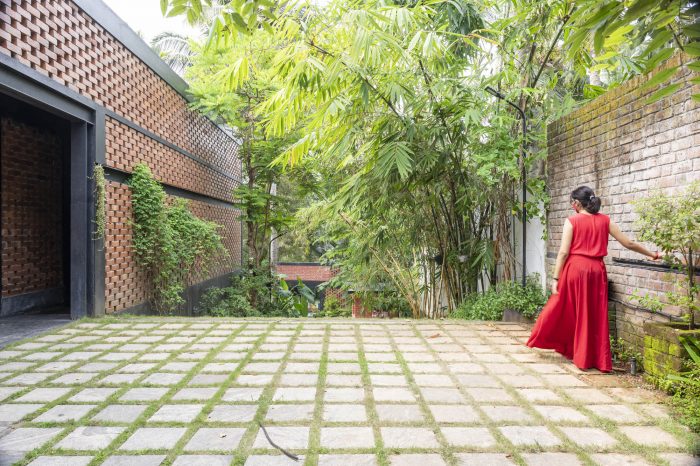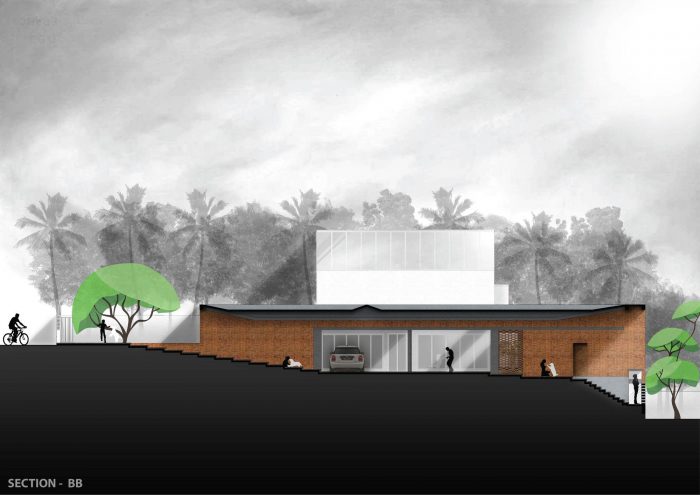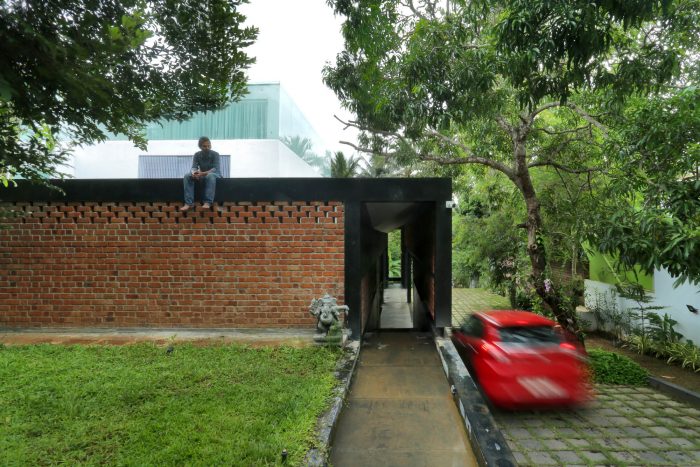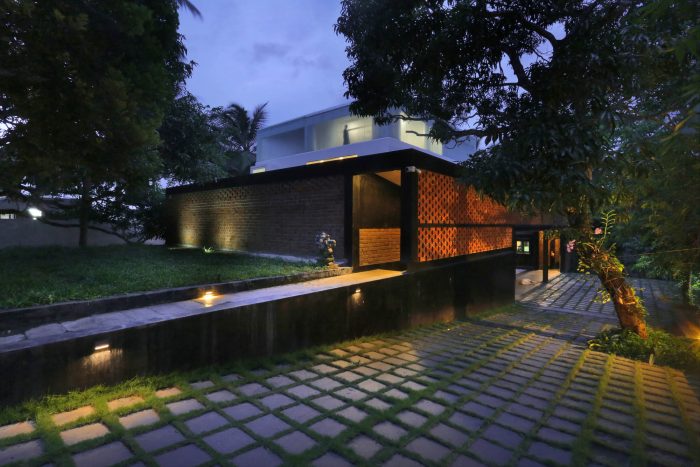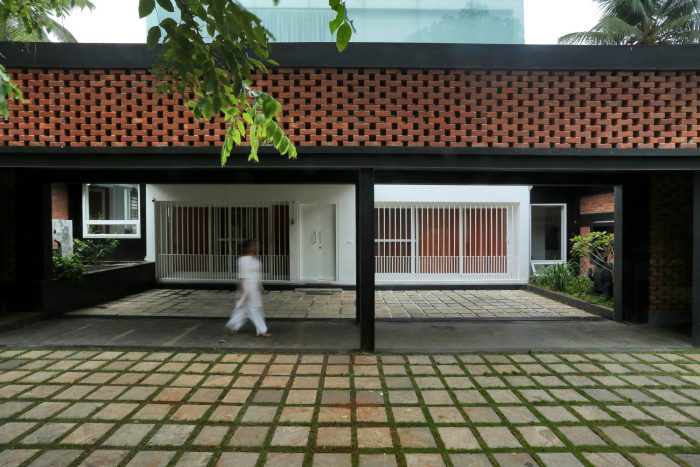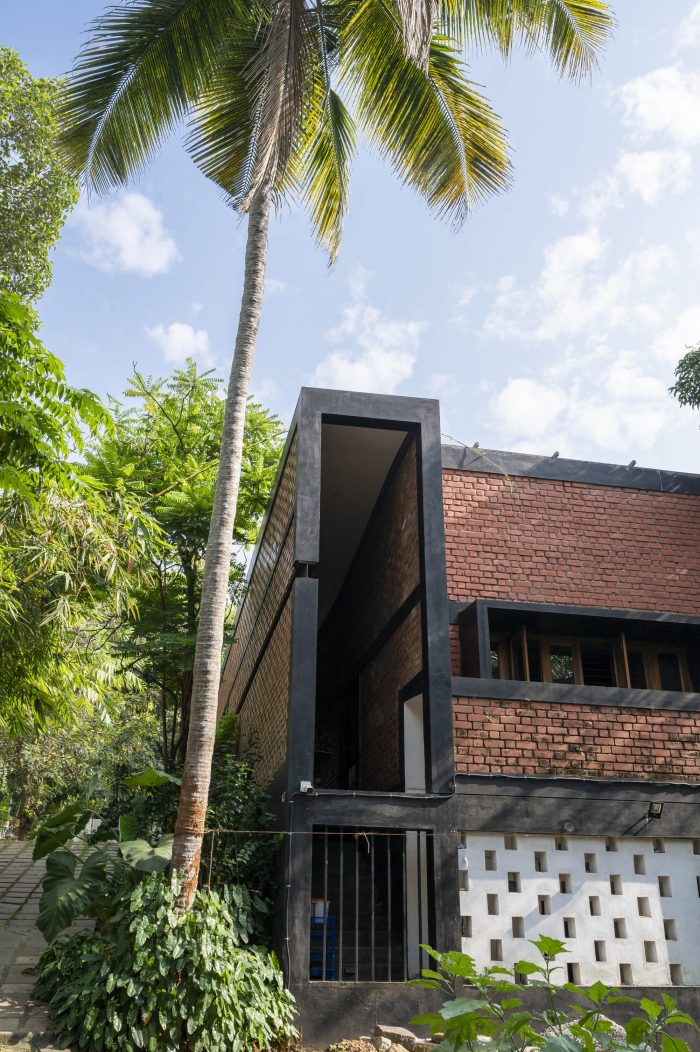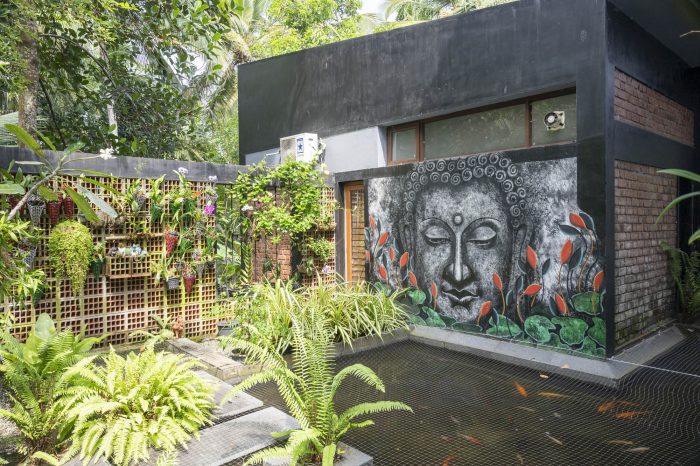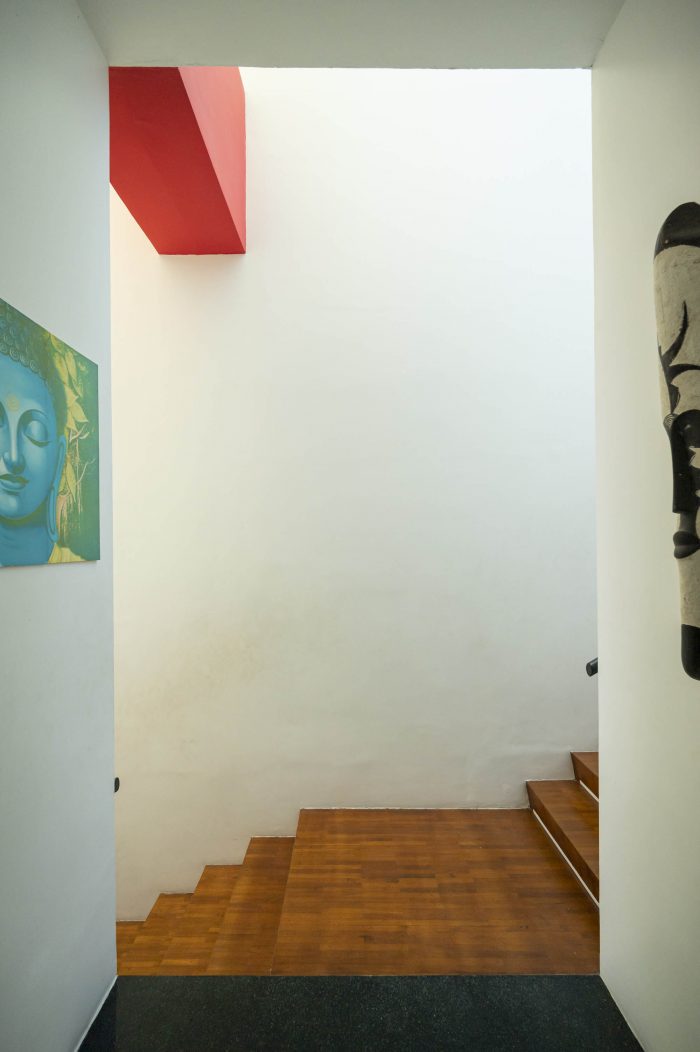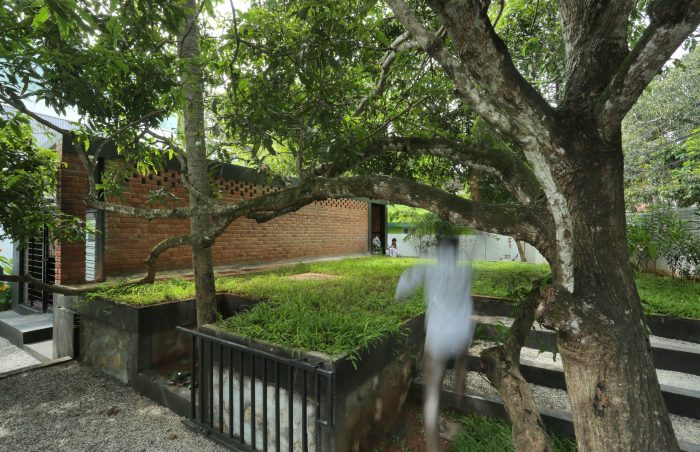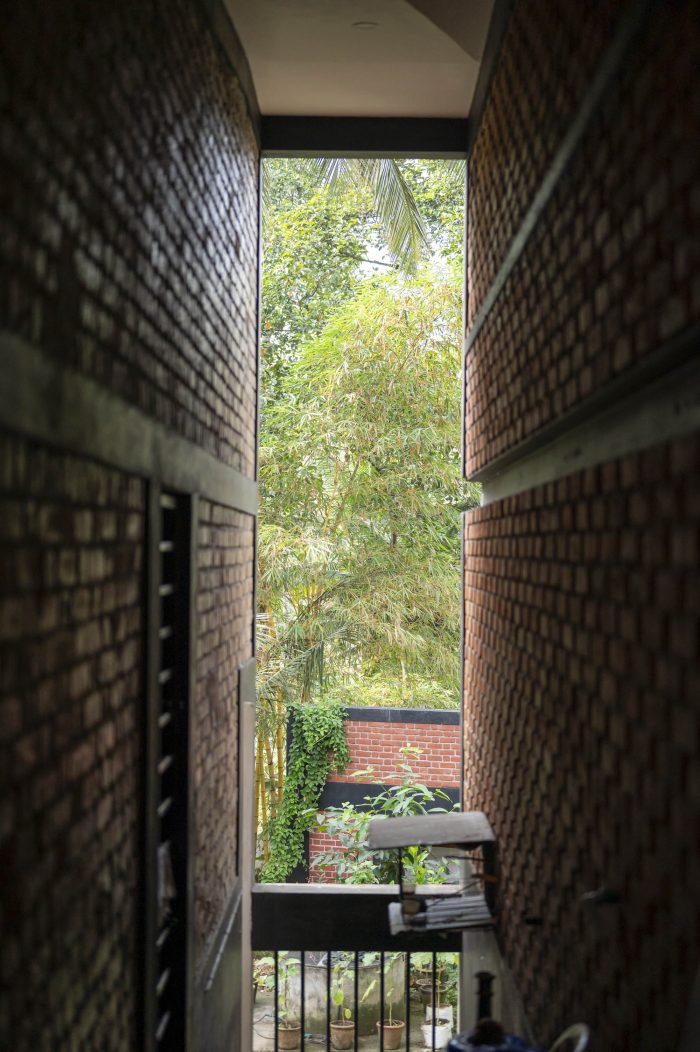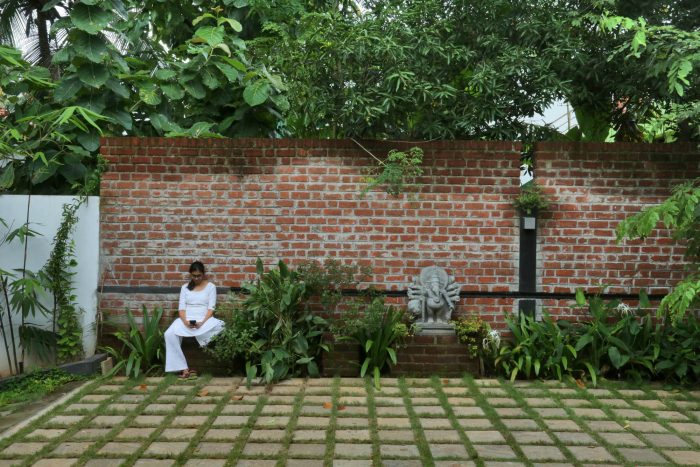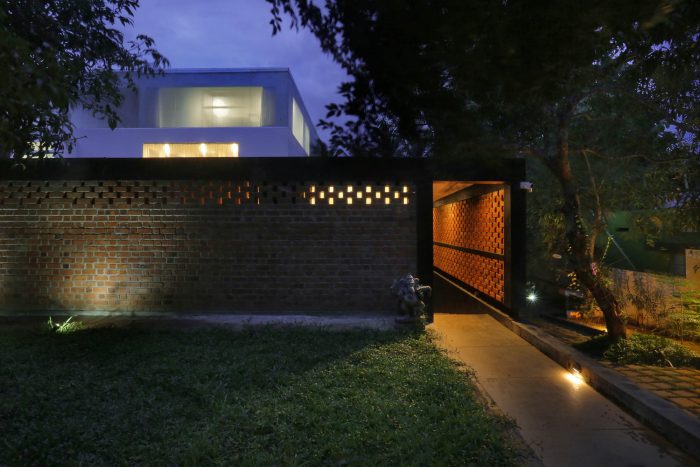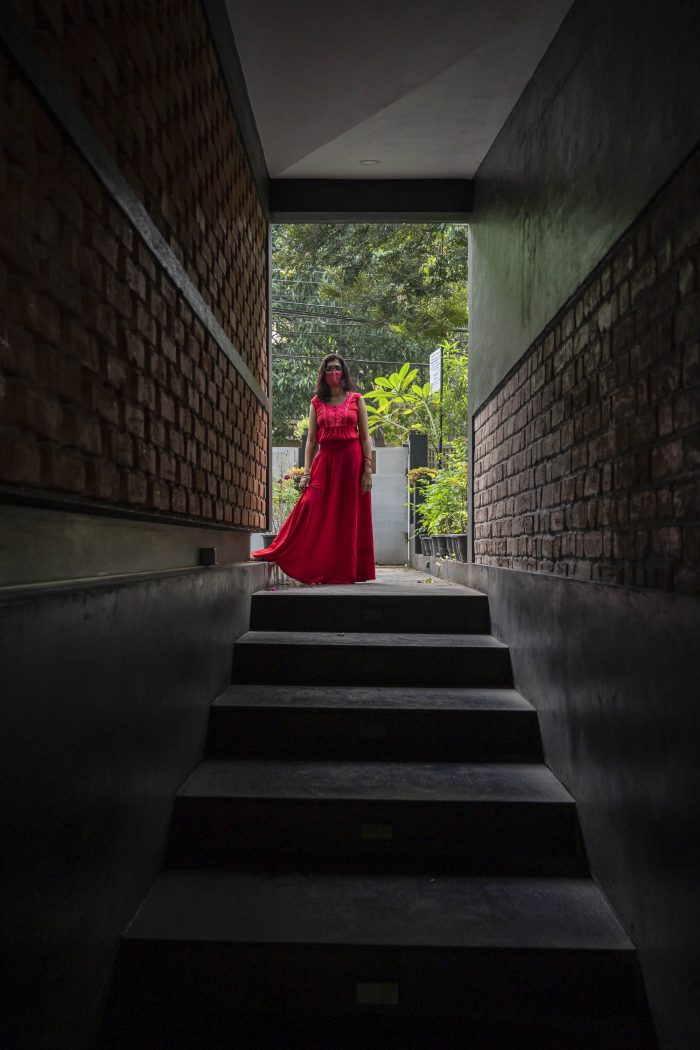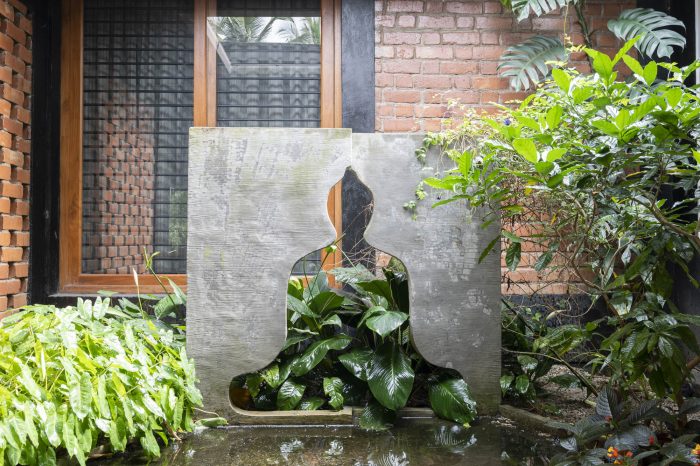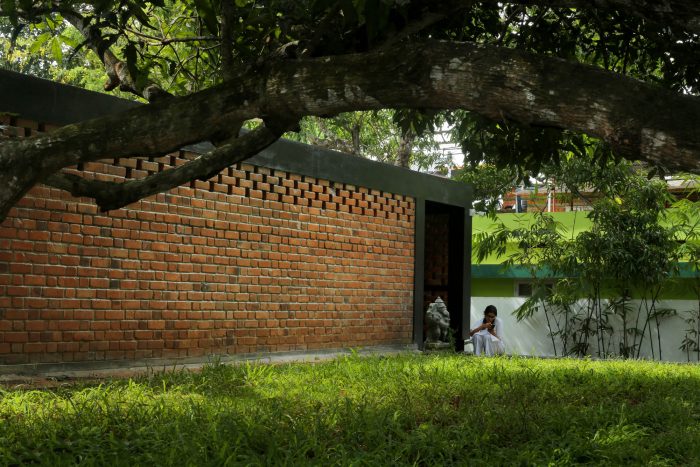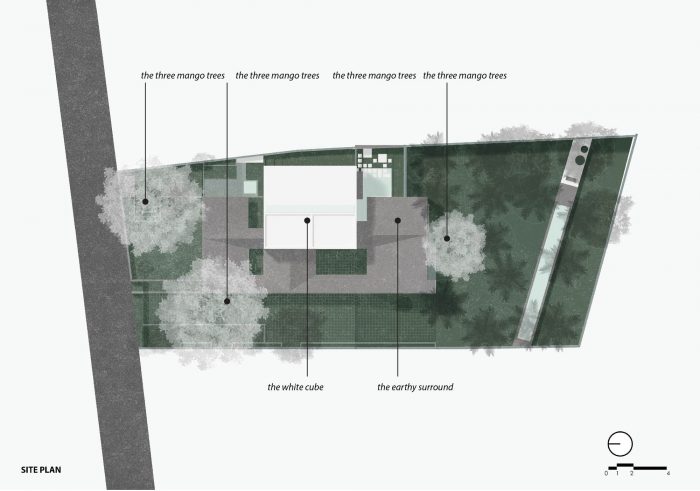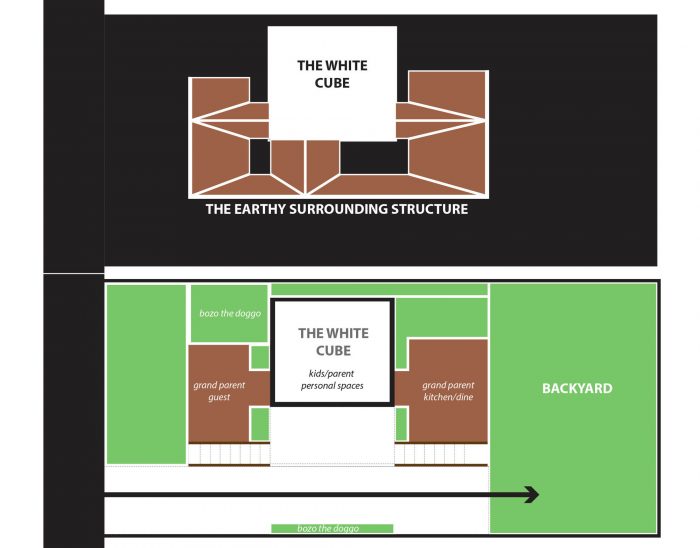Hareesh博士和Anju博士是喀拉拉邦特里凡得琅的著名医生,他们提出了在一片绿意盎然的土地上建造他们的家的要求,两边是巨大的芒果树。Hareesh医生通过旅行接触到的世界需要一个现代化的房子。爷爷奶奶对老房子建造的时代有记忆,需要传统住宅的体验。安茹博士喜欢现代和传统,是一个狂热的古玩收藏家,这就需要有空间来展示它们。
Dr.Hareesh and Dr.Anju, well known doctors in Trivandrum, Kerala, came up with the requirements of building their home, in a lush green site flanked by huge mango trees. Dr Hareesh’s exposure to the world through travels required a modern house. The grandparent had memories of the times the old house was built and required experiences of traditional homes. Dr. Anju loved the modern and the traditional and was an avid collector of curios, which required spaces to exhibit them.
她对园林和自然的兴趣,奶奶对那三棵芒果树的眷恋,她亲眼目睹了这三棵芒果树长到现在的身材,孩子们和宠物们让景观成为了房子的重要组成部分。父母、奶奶、两个孩子和他们的宠物,给我们提出了一个挑战,即如何与不同世代和类型的用户合作。这种对空间建构的二元对立的需求,作为房子的核心内容进行了探讨。混合多元的家》探索了传统内容的空间,与现代家居的特点纠缠在一起。两种空间建构相互作用,相互探索,通过与芒果树相关的花园–芒果树比所有人都先存在。
Her interests in gardens and nature, the grandmother’s attachment to the three mango trees which she had seen grow to the stature they are in right now, the kids and pets made landscape an important part of the house. The parents, grandmother, two kids and their pet, presented with us a challenge to work with different generations and types of users. This need for dichotomy of spatial constructs was explored as the core content of the house. Home of Blended Pluralities explores spaces of traditional content, entwined with the features of a modern home. Both the spatial constructs interact and explore each other, through the gardens associated with the mango trees- who existed before all.
质量 。为了给新家让路,工地上现有的建筑不得不被拆除。旧建筑是一个巨大的混凝土块,两侧是芒果树。当人们走到建筑之外时,它让位于一个斜坡上美丽的当地野生景观和场地之外郁郁葱葱的绿色植被。这所产生的悬念令人神往。新建筑也是我们这种直观体验的产物,《混合多元的家园》是从街道到绿地之外的编排运动,以建筑空间为邂逅到花园两侧的空间。
Massing . The existing building on site had to be demolished to give way to the new home. The old building was a huge concrete block, flanked by the mango trees. As one moves beyond the building, it gave way to a beautiful local wild landscape on a slope and lush green vegetation beyond the site. The suspense this created was enthralling. The new building was also a product of this intuitive experience we had, The Home of Blended Pluralities is a choreographed movement from the street to the green beyond, with built spaces as encounters to spaces flanked by gardens.
场地沿长度方向向下倾斜了约20英尺,形成了天然的排水线,并随之形成了有趣的地形。这里有巨大的树木和植被,它们存在于任何使用者之前。该建筑被放置在与被拆除的建筑相接触的地方,因此没有砍伐树木,也没有移除肥沃的表土。它远离了任何已存在的元素,并为其让路;保持树木的完整,与斜坡对齐,沿着场地编排运动,探索其特征–建造一些不够响亮的东西,但却能说出自己的语言。
The site sloped down about 20 feet along its length, creating natural drainage lines and an interesting topography along with it. There were huge trees and vegetation, which existed before any of its users. The built was placed such that it touched the site where the demolished building stood so that no tree was cut and no fertile topsoil removed. It moved away from, and made way for, any pre-existing elements; keeping the trees intact, aligning with the slope, choreographing the movement along the site exploring its features- to build something that wasn’t loud enough, but speaks its own language.
内容 。几代人在空间偏好上存在断层,老人喜欢小空间,带有泥土气息和温暖,下一代人向往白色的现代室内,孩子们可以两者兼得,而宠物们则更喜欢自然和大地,项目是由园林、景观、建筑、人和自然这些空间相互连接的集合,在二元对立之间交替平衡。中央的白色立方体夹在周围的土质坡屋顶雨场之间,而花园则转化了人、空间和体验之间的二元对立。
Content . There exists a disconnect between the generations in terms of their spatial preferences, the elderly liked smaller spaces with a tinge of earthiness and warmth, the next generation aspired for white modern interiors, kids could be introduced to both, and the pets preferred nature and earth, The project is a collection of these spaces interconnected by gardens, landscape, architecture, humans and nature, alternating equilibriums between dichotomies. The central white cube is sandwiched between the earthy sloped roof rain courts that surround it, while the gardens translate the dichotomies between people, spaces and experiences.
向现有的事物致敬,并编排建造的舞蹈。入口由8英尺的裸露砖墙接待,浸入土中形成客人区,夹在现有的芒果树之间,有一个小的空隙,通过 “黑暗的阶梯走廊 “将人吸引到绿地之外,并对绿地作出承诺。场地沿着其较长的一侧向下倾斜了近20英尺;建筑沿着坡度在现有的树冠之间进行了精心设计。阶梯式的走廊与砖砌的屏风墙紧贴着斜坡,将建筑、景观和场地分开,让人通过这个门槛。这段台阶带着人们向下追寻绿色,沿途遇到居住空间的天井。
Homage to the existing and choreographing the built . The entry was received by an 8 feet exposed brick wall, dipped into the earth forming the guest area, sandwiched between the existing mango trees with a small void, drawing one into the greens beyond through ‘the dark stepped corridor’ with a promise of the greens. The site slopes down almost 20 feet along its longer side; the built is choreographed along the slope amongst the existing canopy. The stepped corridor with its brick screen walls hugging the slope, separates the architecture, landscape and the site, to one journeying through this threshold. This flight of steps takes one down in pursuit of the greens, encountering patios which house the living spaces along the journey.
当人们穿过被多孔墙包裹的阶梯走廊时,它将景观和建筑隐藏起来,过滤起来,并将其放置在舞台上。其多孔的土质材料将人类的存在与景观隔绝开来,让自然界中不那么犹豫的居民(鸟类、松鼠、啮齿动物和昆虫)得以自由使用。老房子的单一体量减少了,房子有三个部分(客人区/公共区和家庭区),由一条线性阶梯走廊连接,通过精心设计的景观花园通往绿色后院。当我们沿着它移动时,我们遇到的房子是孤立的单位,夹在斜坡上的花园之间。
As one journeys through the stepped corridor wrapped by it porous wall, it hides, filters and stages the landscape and the built. Its porous earthen materiality shields the presence of humans from the landscape, freeing nature to be used by its less hesitant occupants (birds, squirrels rodents & insects). The hugeness of a single mass (of the old house) was reduced; the house had three parts (The guest area/ the common area and the family area) connected by a linear stepped corridor leading to the green backyard through choreographed landscaped gardens. As we move along it we encounter the house as isolated units sandwiched between gardens along the slope.
当人们沿着阶梯走廊到达第一层,进入一个铺设好的天井时,就会遇到白色的中央立方体,将公共家庭空间推到一边,给天井带来最大的开放性。立方体中包含了孩子们的卧室,从上面可以俯瞰两边的绿地,主卧则有一个私人水庭,可以看到绿色的后院。再往下走,就会遇到家庭空间,厨房和祖父母空间,可以俯瞰绿地。
As one reaches the first level along the stepped corridor into a paved patio, one meets the white central cube, pushing the common family space pushed to a side, giving maximum openness to the patio. The cube contains the kids’ bedrooms overlooking the greens on either side from above, and the master bedroom with a private water court looking out into the green backyard. Moving down further, one encounters the family spaces, the kitchen and grandparent space overlooking the greens.
自然印在玻璃上 。充满雨水的老院子一直是人们怀旧的一部分。他们仍然渴望它们,但他们害怕下雨,害怕潮湿,害怕水汽,害怕随之而来的小生命体–THEY FEAR NATURE。这个项目将这些记忆转换为他们玻璃窗上的影像,在保留影像的同时,也割舍了经验。人们可以在舒适的玻璃窗内观看它们的展开;但要成为其中的一部分,就必须冒险进入球场。
Nature printed on glass . The old rain filled courtyards have been a part of people’s nostalgia. They still long for them, but they fear rains, the dampness, the moisture, and little life forms that come with it- THEY FEAR NATURE. The project converted these memories into images on their glass windows, keeping the image while cutting out the experience. One can watch them unfold from within the comfort of glazed openings; but to be a part of it, one must venture out into the courts.
建筑师:Ego Design Studio
面积:500 m²
年份:2019年
摄影作品:Running Studios, Niby Thomas
制造商:Berger Paints, CAD, Fenesta, Kajaria
牵头建筑师:Niranjan C Warrier、Jerry Sam Joseph、Jayaram G S、Aarati Binayak、Abhilash U A、Sudheesh S、Aravind T
设计团队:Niranjan C Warrier, Jerry Sam Joseph , Abhilash U A , Jayaram G S , Aravind T
项目管理:Sudheesh S,Varsha Cletus
景观设计师:Aarati Binayak (down to earth)
景观设计师:Down to Earth
城市:Thiruvananthapuram
国家:印度
Architects: Ego Design Studio
Area: 500 m²
Year: 2019
Photographs: Running Studios, Niby Thomas
Manufacturers: Berger Paints, CAD, Fenesta, Kajaria
Lead Architects:Niranjan C Warrier, Jerry Sam Joseph, Jayaram G S, Aarati Binayak, Abhilash U A, Sudheesh S, Aravind T
Design Team:Niranjan C Warrier, Jerry Sam Joseph , Abhilash U A , Jayaram G S , Aravind T
Project Management:Sudheesh S, Varsha Cletus
Landscape Architect:Aarati Binayak (down to earth)
Landscape Architects:Down to Earth
City:Thiruvananthapuram
Country:India

